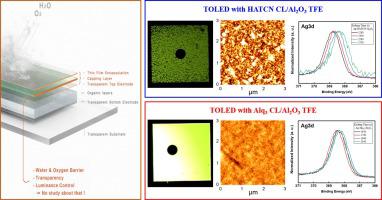当前位置:
X-MOL 学术
›
J. Ind. Eng. Chem.
›
论文详情
Our official English website, www.x-mol.net, welcomes your feedback! (Note: you will need to create a separate account there.)
A Systematic Study of the Interactions in the Top Electrode/Capping Layer/Thin Film Encapsulation of Transparent OLEDs
Journal of Industrial and Engineering Chemistry ( IF 6.1 ) Pub Date : 2021-01-01 , DOI: 10.1016/j.jiec.2020.09.029 Byoung-Hwa Kwon , Hyunkoo Lee , Moohyun Kim , Chul Woong Joo , Hyunsu Cho , Jong Tae Lim , Yeon Sik Jung
Journal of Industrial and Engineering Chemistry ( IF 6.1 ) Pub Date : 2021-01-01 , DOI: 10.1016/j.jiec.2020.09.029 Byoung-Hwa Kwon , Hyunkoo Lee , Moohyun Kim , Chul Woong Joo , Hyunsu Cho , Jong Tae Lim , Yeon Sik Jung

|
ABSTRACT Development of flexible transparent organic light-emitting devices (TOLEDs) still requires a number of advancements in transparent conducting electrodes with low reflection and absorption, a capping layer (CL) acting as refractive index-matching, and thin film encapsulation (TFE) with high water vapor barrier properties, among others. While substantial research has been reported on isolated examples in each area, there has been no detailed and systemic research related to the overall interactions of top electrodes, CLs, TFE, and their interfaces. In this work, TOLEDs have been fabricated with a thin Ag top electrode and CLs of different surface energy, which was encapsulated with high water vapor barrier property (1.35Ⅹ10−4 gm−2day−1 at 37.8 °C and 100 % RH). The encapsulation barrier was comprised of 50-nm-thick Al2O3 thin films deposited using a low-temperature (95 °C) ALD process. Once prepared, the TOLEDs were studied using a variety of techniques to determine the enhancements to electrical, optical, and water vapor barrier properties. Although the nature of the CL materials affects the film formation on the top electrode layer, there is no impact on the properties of the Al2O3 thin films. In the formation process of the Al2O3 TFE, the device incorporating a tris(8-hydroxyquinoline)aluminum (Alq3) CL showed superior performance, whereas device performance degredation was noted with the 1,4,5,8,9,11-hexaazatriphenylene-hexacarbonitrile (HATCN) CL. The lack of degradation in the Alq3 CL device during ALD processing is attributed to the high thermal stability of Alq3, which exhibits a high glass transition temperature of 175 °C. However, in the HATCN CL device, it is expected that formation of aromatic radical anions [HAT(CN)6]•− and dianions [HAT(CN)6]2−, and/or band bending of fermi energy of the HATCN at the interface of the thin Ag layer, results in the observed degraded performance.
中文翻译:

透明OLED顶部电极/覆盖层/薄膜封装相互作用的系统研究
摘要 柔性透明有机发光器件 (TOLED) 的发展仍然需要在具有低反射和吸收的透明导电电极、用作折射率匹配的覆盖层 (CL) 和薄膜封装 (TFE) 方面取得进展。高水蒸气阻隔性能等。虽然已经对每个领域的孤立实例进行了大量研究,但还没有与顶部电极、CL、TFE 及其界面的整体相互作用相关的详细和系统研究。在这项工作中,TOLED 用薄的 Ag 顶部电极和不同表面能的 CL 制造,并以高水蒸气阻隔性(1.35Ⅹ10−4 gm−2day−1,37.8 °C 和 100% RH)封装。封装屏障由使用低温 (95 °C) ALD 工艺沉积的 50 nm 厚的 Al2O3 薄膜组成。制备完成后,使用各种技术对 TOLED 进行研究,以确定对电气、光学和水蒸气阻隔性能的增强。尽管 CL 材料的性质会影响顶部电极层的成膜,但对 Al2O3 薄膜的性能没有影响。在 Al2O3 TFE 的形成过程中,包含三(8-羟基喹啉)铝 (Alq3) CL 的器件表现出优异的性能,而使用 1,4,5,8,9,11-六氮杂三亚苯基-六甲腈 (HATCN) CL。在 ALD 处理过程中 Alq3 CL 器件没有退化是由于 Alq3 的高热稳定性,其玻璃化转变温度高达 175 °C。然而,在 HATCN CL 装置中,预计会形成芳香自由基阴离子 [HAT(CN)6]•- 和二价阴离子 [HAT(CN)6]2-,和/或 HATCN 的费米能带弯曲在薄银层的界面导致观察到的性能下降。
更新日期:2021-01-01
中文翻译:

透明OLED顶部电极/覆盖层/薄膜封装相互作用的系统研究
摘要 柔性透明有机发光器件 (TOLED) 的发展仍然需要在具有低反射和吸收的透明导电电极、用作折射率匹配的覆盖层 (CL) 和薄膜封装 (TFE) 方面取得进展。高水蒸气阻隔性能等。虽然已经对每个领域的孤立实例进行了大量研究,但还没有与顶部电极、CL、TFE 及其界面的整体相互作用相关的详细和系统研究。在这项工作中,TOLED 用薄的 Ag 顶部电极和不同表面能的 CL 制造,并以高水蒸气阻隔性(1.35Ⅹ10−4 gm−2day−1,37.8 °C 和 100% RH)封装。封装屏障由使用低温 (95 °C) ALD 工艺沉积的 50 nm 厚的 Al2O3 薄膜组成。制备完成后,使用各种技术对 TOLED 进行研究,以确定对电气、光学和水蒸气阻隔性能的增强。尽管 CL 材料的性质会影响顶部电极层的成膜,但对 Al2O3 薄膜的性能没有影响。在 Al2O3 TFE 的形成过程中,包含三(8-羟基喹啉)铝 (Alq3) CL 的器件表现出优异的性能,而使用 1,4,5,8,9,11-六氮杂三亚苯基-六甲腈 (HATCN) CL。在 ALD 处理过程中 Alq3 CL 器件没有退化是由于 Alq3 的高热稳定性,其玻璃化转变温度高达 175 °C。然而,在 HATCN CL 装置中,预计会形成芳香自由基阴离子 [HAT(CN)6]•- 和二价阴离子 [HAT(CN)6]2-,和/或 HATCN 的费米能带弯曲在薄银层的界面导致观察到的性能下降。



























 京公网安备 11010802027423号
京公网安备 11010802027423号